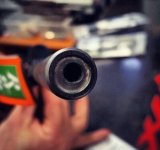Polygonal rifling will generally provide an increase in velocity over a standard cut rifled barrel, and poly barrels typically have less bearing surface between the bullet and barrel.
So, to me it would make sense that less grooves = less bearing surface = more velocity.
I'll disagree.
We've made polygonal rifle pressure test barrels for a ammunition and bullet maker. They wanted to test different rifling profiles etc...mostly coming at it from a standpoint of accuracy and how it effects long range accuracy on the bullet but they did pressure testing as well.
This was done in this case in 300WM and the polygonal rifling did not produce any higher velocities. So after that test they abandoned pursuing any more testing with polygonal rifling because they actually seen a little drop in velocity and that they didn't want to see at all.
If you look at the total surface area of the bore and you run the same dimensions/tolerances in the bore and groove in a barrel (also regardless of twist) and your using the same chamber reamer spec...you shouldn't see any significant difference in pressures and velocities.
So when a someone tells you this or that makes the barrel faster....you/they better know the details of the barrel. You should also know the bore and groove size to the 4th decimal place. If you don't know the dimensions...now your guessing as to what is going on.
Are the barrels made to the same bore and groove spec dimension wise?
Is the ratio of the groove widths the same?
Is the same chamber reamer spec being used in all of the barrels?
Not to mention ammo being shot thru it.
You change any of the above spec...you can effect velocities and pressures as well as
bullet diameters will effect things. Here are a couple of examples....
Changing the groove size has a bigger impact in pressures and velocities. I've seen pressure test barrels where the the bore and groove both where -.0005" undersize vs. the min spec. + the tolerance of .0005". That .0005" undersize dimensions raised the pressures 8000 to 10,000psi and drove up the velocities around 150fps. to almost 200fps. Same 6 groove barrels etc...just the one barrels where .0005" undersize on both the bore and groove.
Look at the chamber now...you start changing the throats freebore diameter and or length you can effect pressures and velocities as well. I seen on some 300AAC Blackout test barrels that we made....where the reamer cut the throat only .0001" to maybe .0002" undersize! Depending on which bullet you ran thru the barrels (some rocket scientist spec'd the bullet could be as large as .3090" diameter) well the throat is spec'd at .3090" diameter. So when they ran the bullets that where at .3090" diameter in the barrels (which is size on size with what the reamer is suppose to cut the chamber to and is the start of having problems) and in this case the reamer cut the throat to .3088"/.3089". It bumped pressures up 6k psi and also drove up the velocities. We got the barrels back and got a new reamer and just recut the chambers by hand....all of the barrels pressures and velocities dropped right into spec. That little difference of .0001" or so is all that it took to change things.
So it's
more about uniformity and tolerances and dimensions and it's less about the style and number of grooves from everything I've seen.
So one of the things you will hear me say...."the straighter the barrel blank, the more uniform the bore and groove dimensions are over the length of the barrel, the more uniform the twist and the more stress free the barrel blank is....the more forgiving the barrel is going to be."
Later, Frank
Bartlein Barrels


